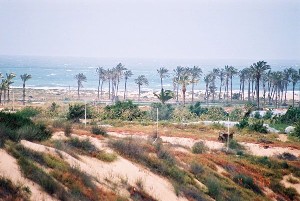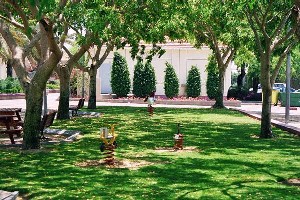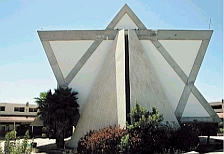 Gaza, or in Hebrew Azzah, is a city on the southern coastal plain of Eretz Israel. It was captured and conquered by the men of the tribe of Yehudah (Shoftim 1:18) and was included in the allotment given to that tribe (Joshua 15:47).
Gaza, or in Hebrew Azzah, is a city on the southern coastal plain of Eretz Israel. It was captured and conquered by the men of the tribe of Yehudah (Shoftim 1:18) and was included in the allotment given to that tribe (Joshua 15:47).
At Gaza, took place the famous saga and story of Samson who performed his miraculous feats of strength. Samson perished while slaughtering his enemies (Shoftim 16). The enemy finally submitted to David who slew the giant Goliath in battle (Shmuel II 5:25).
Gaza was the only city in its area to oppose Alexander the Great during 332 B.C.E. Later on it was an outpost of the Ptolemies, who were the ruling power in Egypt during the Hellenistic period, until its capture in 98 B.C.E. by Assyria’s Antiochus III, the Seuclid king in control of an empire.
The city was subsequently attacked and reconquered by Jonathan the Hasmonean during 145 B.C.E. (1 Macc. 11:61-62) During the Hasmonean civil war, the city was taken by Alexander Janneaeus in 96 B.C. E. The Roman Pomey restored the city and Galbinus, also a Roman official, rebuilt the city (ca 57 B.C.E.).
King Herod the Great held the city for a short time, but after his death it came under the authority of the Roman proconsul of Syria. It flourished as a Roman city and remained a center for the Jewish community and emerging Christian community throughout the Roman era (963 B.C.E. through 324 C.E.) and continued into the Byzantine period 324 C.E. through 1453 C.E. According to the Karaite Sahl b. Mazli’ah, Gaza, Tiberias and Zoar were the three centers of pilgrimages in Eretz Yisrael during the Byzantine period.
 In a great battle fought near Gaza in 635 C.E., the Arabs vanquished the Byzantines; the city itself fell soon afterward. It remained the seat of the governor of the Negev, as is known from the Nessana Papyri.
In a great battle fought near Gaza in 635 C.E., the Arabs vanquished the Byzantines; the city itself fell soon afterward. It remained the seat of the governor of the Negev, as is known from the Nessana Papyri.
In the eighth century, R. Moses, one of the Masorites, lived there. The Judean and Samarian communities of the Jewish people flourished under Arab rule. Again there were a succession of attackers, conquerors and occupiers of Jewish Gaza.
King Baldwin I of Jerusalem occupied the city, which was known in Crusader occupation times as Gadres. From the time of Baldwin III (1152 C.E.) it was a templar stronghold. In 1170 it fell to Saladin. Under Mamluk occupation and rule Gaza was capital of a district (mamlaka) embracing the whole coastal plain up to Athlit.
In the eleventh century, R. Ephraim of Gaza, was head of the community of Fostat (old Cairo). Meshullam of Volterra found 60 jewish householders there during 1481 C.E. All the wine of Gaza was produced by the Jews (A.M. Luncz, in Yerushalayim, 1918). Obadaiah of Bentinoro records that when he was there in 1488, Gaza’s rabbi was a certain Moses of Prague who had come from Jerusalem.
 Gaza flourished under Ottoman rule. The Jewish community was once again flourishing and prosperous during the 16th and 17th centuries. The Kairite Samuel b. David found a Rabbanite synagogue there in 1641. In the 16th century there was a bet din and yeshivah in Gaza. Some of its rabbis wrote scholarly works. Farmer owners were obliged to observe the laws of terumah, maasrot, and the sabbatical year.
Gaza flourished under Ottoman rule. The Jewish community was once again flourishing and prosperous during the 16th and 17th centuries. The Kairite Samuel b. David found a Rabbanite synagogue there in 1641. In the 16th century there was a bet din and yeshivah in Gaza. Some of its rabbis wrote scholarly works. Farmer owners were obliged to observe the laws of terumah, maasrot, and the sabbatical year.
At the end of the 16 th century, the Najara family supplied some of its Rabbis. Israel Najara, son of the Damascus Rabbi Moses Najara, author of the “Zemirot Yisrael” was Chief Rabbi of Gaza and president of the Bet Din in the mid 17 th Century. In 1665, on the occasion of Shabbatai Zevi’s visit to Gaza,the city became a center of the messianic movement. One of his principle disciples was Nathan of Gaza.
The city of Gaza was briefly occupied once again this time by Napoleon in 1799. In the 19th century the city of Gaza declined. The Jews that were concentrated there were mostly barley merchants. They bartered with the Bedouins for barley which they exported to the beer breweries of Europe.
Gaza was a Turkish stronghold during World War I. Two British attacks made on Gaza during 1916-17 failed and it was finally taken during a flanking movement by Allenby. Under British Mandatory occupation and rule, Gaza developed slowly. The last Jews living in Gaza left the town as result of the Arab anti-Jewish disturbances and massacres which took place during 1929. In 1946, Gaza’s population was estimated at 19,500, all Muslim except for 720 Christians.
 During Israel’s defensive “War of Independence” when five Arab armies invaded the re-established Jewish homeland with the intent of its annihilation, the invading Egyptian army attacked, conquered, and occupied Gaza, from May 1948 through June 1967 when it again attacked Israel with the intent to annihilate the only Jewish homeland in the world from the map, and Israel defeated its attackers and conquered the land.
During Israel’s defensive “War of Independence” when five Arab armies invaded the re-established Jewish homeland with the intent of its annihilation, the invading Egyptian army attacked, conquered, and occupied Gaza, from May 1948 through June 1967 when it again attacked Israel with the intent to annihilate the only Jewish homeland in the world from the map, and Israel defeated its attackers and conquered the land.
The town together with the newly created Gaza Strip, was put under Egyptian administration by the armistice agreement of 1949. The influx of Arab refugees, who were told by the Arab aggressors and attackers they could soon return after the Jews “were driven into the sea” later, swelled the city’s population at least fourfold.
It must be recalled that most of the Arabs living in Israel only came in the middle to late 1920’s to escape economic hardship and political persecution by their own people for better opportunity.
The 1967 census showed that 87,793 Arab inhabitants and settlers lived in Gaza City proper, while only 30,479 lived in a refugee camp within the municipal boundaries. Of this number 1,649 were Christians and the rest were Muslims.
In 1965, a mosaic pavement was discovered by the Egyptian Department of Antiquities. This mosaic dated 508/9 was uncovered on the seashore of Gaza’s harbor. Its figures include one of King David as Orpheus, dressed in Byzantine royal garments and playing the harp. The name “David” in Hebrew letters appears above it. A Greek inscription at the center of the floor, which mentions the names of two donors (Menahem and Jesse) of the mosaic to the “holy place” and the name David testify that a synagogue stood there.
In 1967, A. Ovadiah excavated the area and discovered a synagogue from the sixth century C.E. Archaeology evidence supports the biblical premise of a continuous Jewish presence from the Late bronze period until the Byzantine period (ca. 1500 B.C.E. through 632 C.E.)
Copyright © 1995 - 2025 Ahavat Israel. All rights reserved.